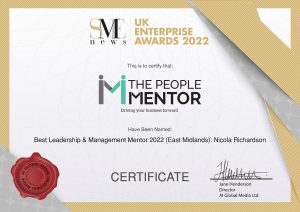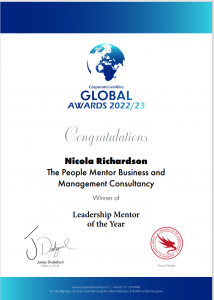Hi, I’m Nicola from The People Mentor. Today I want to talk about building a powerful culture and how it is key to the success of any SME business.
A strong company culture can help you attract and retain talented employees, improve productivity and efficiency, increase customer satisfaction, and ultimately drive business growth.
Let’s look at what a poor culture could look like in the business world.
A Dysfunctional Team
ABC Inc. is a small firm that specialises in IT project management. The company has been in business for five years and has grown to 20 employees. However, the culture at ABC Inc. is toxic and dysfunctional.
The company’s founder and CEO, Jack, is a micromanager who is constantly checking on his employees’ work and giving them conflicting instructions. Jack is also prone to outbursts and yelling at his employees when they make mistakes. This has led to a culture of fear and anxiety among the employees.
The employees at ABC Inc. are also competitive with each other, rather than collaborative. They are reluctant to share information or ask for help, for fear of being perceived as incompetent.
As a result of the dysfunctional culture, ABC Inc. has a high turnover rate. Employees are frequently quitting or getting fired, which has led to a loss of institutional knowledge and client relationships.
The company’s clients have also noticed the dysfunctional culture at ABC Inc. They have complained about missed deadlines, poor communication, and a lack of quality work. This has led to a loss of business and a damaged reputation for the company.
Overall, the dysfunctional culture at ABC Inc. has had a negative impact on the company’s employees, clients, and bottom line.
How to Identify the Issues.
If you are seeing this in your business, then you have a problem.
I’d start with these questions to assess your culture.
- What are the core values of your organisation, and are they being upheld by your employees?
- How do employees feel about your culture? Are they engaged and motivated, or are they disengaged and unhappy?
- How do you communicate with your employees, and are you creating an environment of open communication and transparency?
- Are your employees encouraged to share their opinions, ideas, and feedback, and are those suggestions being considered and acted upon?
- How do you celebrate success and recognise employees for their hard work and achievements?
- Is there a sense of trust and respect between employees and leadership, or is there a culture of fear and anxiety?
- How do you handle conflicts and difficult conversations within the business?
- Are you promoting collaboration and teamwork, or is there a sense of competition and silos within the business?
- How do you ensure that your culture is inclusive and diverse and that everyone feels valued and respected regardless of their background or identity?
- How do you continuously assess and improve your culture to ensure that it remains strong and aligned with your values and goals?
Now What?
After you’ve reviewed your findings, it’s important for you to take action based on the feedback and insights gained.
You may spot one or two areas that need some work and that’s okay because most businesses are not 100% okay. The key thing is to review and take action.
So, start by analysing the results and identifying what needs improvement. Can you see any patterns and themes in the feedback you received? Don’t forget to Identify areas where your culture is strong, as well as areas where improvements can be made. People often concentrate on the improvements only. This is when the stronger areas slide backwards as you forget to keep up the work on those parts.
Remember to communicate with your employees. Share the results of your assessment with employees and communicate what you plan to do to improve the culture. Encourage employees to provide ongoing feedback and suggestions and get involved.
A neglected area especially at times of cost cutting is training and resources. If you want a skilled and efficient workforce, then providing training and resources to help employees with their skills as well as understand and embrace the desired culture is essential. I’ve seen training cut on many an occasion in operational areas and this is destructive to growth and creating improvements.
Remember to continuously assess and improve. Culture doesn’t stay still, and it’s important to continuously assess and improve your culture. Regularly ask for feedback, track progress, and adjust your approach as needed.

Some good reading to do.
Recently I read Daniel Coyle’s “The Culture Code”. His approach mirrors what I have seen in successful organisations and is how I lead. His approach covers that building a strong culture is based on the idea that culture is not a set of rules or policies, but a set of behaviours that are reinforced over time.
In his book, Coyle outlines three key elements of a strong culture: building safety, sharing vulnerability, and establishing purpose.
The first one is building safety.
Building safety means creating an environment where employees feel comfortable and secure. This includes building trust among employees, creating a sense of belonging, and promoting an atmosphere of mutual respect. Coyle suggests that leaders can build safety by encouraging feedback and open communication and creating opportunities for employees to connect on a personal level.
Next is sharing vulnerability.
Sharing vulnerability means creating an environment where employees feel comfortable sharing their mistakes and weaknesses.
This can help to build trust and foster a culture of learning and growth.
Coyle suggests that leaders can encourage vulnerability by being open about their own mistakes and weaknesses, creating an atmosphere of psychological safety, and framing mistakes as opportunities for growth.
I remember owning up to mistakes, I had made.
And I recall a work conference where I felt like a fish out of water, and I was really struggling. As a team we were there together and in a moment of vulnerability, I told the team who pulled together to support me.
The third key element is establishing purpose:
Establishing purpose means creating a sense of shared vision and mission among employees.
This can help to motivate employees and align their work with the goals of the organisation. Coyle suggests that leaders can establish purpose by communicating a clear mission and vision, creating opportunities for employees to connect with the organisation’s purpose, and creating a sense of autonomy and ownership among employees.
I think this is spot on. I remember a new team I joined to lead. We really struggled as our purpose had not been defined and as a result, we were not productive. As the lead I felt lost and bewildered and like a headless chicken. Again this is when I showed my vulnerability to my team who felt then able to share how they were feeling.
What I did do as well was escalate to the Senior Leaders that the team were floundering, and we needed a sense of direction and purpose.
I think Coyle’s book is to the point and well worth a read.
Handy’s Model of Organisational Culture
Charles Handy’s model of organisation culture is also worth considering as it will give insights into your culture.
Handy identifies four types of organizational culture. These are the power culture, role culture, task culture, and person culture.
Power culture is characterised by a few individuals who make decisions.
Role culture is focused on rules and procedures.
Task culture is centred around completing tasks.
Person culture values individuals over the organisation as a whole.
These types of cultures are distinct. It’s important to note that many organisations have a mix of cultures rather than one specific type.
For example, a company may have a task culture for its software development team, but a role culture for its finance department.
Understanding the different types of cultures can help you identify strengths and weaknesses in their organisation and develop strategies for improving culture and performance.

If you are finding, you are seeing a dominant type then find a successful leader within the organisation to model your behaviours on.
Also, consider how the dominant style affects your management and leadership style and what may need to change.
10 Ways to make improvements to your culture.
Let’s consider ten ways you can make improvements to your culture and what you are seeing in your organisation.
The first is to establish core values.
Identify the core values that your company stands for and incorporate them into your culture. Make sure your values align with your mission statement and are communicated clearly to all employees.
Next lead by example.
Leaders play a critical role in establishing and maintaining a strong culture. Set an example by living the company’s values and demonstrating the behaviours you expect from employees.
Think about hiring to fit the culture.
When hiring new employees, look for individuals who align with your company’s values and culture. Skills and experience are important, but cultural fit is equally crucial.
As discussed earlier foster open communication.
Encourage open communication among employees and between employees and leadership. Create opportunities for feedback and listen to suggestions and concerns.
The key is building trust.
Trust is the foundation of a strong culture. Build trust by demonstrating transparency, honesty, and integrity. People need to feel safe and that they can open up.

Another important action is to recognise and reward.
Celebrate successes and recognise employees for their hard work and achievements.
Promote teamwork: Encourage collaboration and teamwork rather than competition and silos between departments or teams.
Empowering employees is often talked about. Provide employees with the autonomy and resources they need to succeed. This is where being clear on how to make decisions and who has what responsibility really helps.
Consider how you foster a positive work environment. Create an environment that is welcoming, supportive, and free from discrimination. Develop an approach where people care about each other and are genuinely interested in their team members.
Encourage personal and professional development.
Provide opportunities for employees to learn and grow, whether it’s through training programmes, mentorship, or career development plans. There are so many ways of developing your people from shadowing, and buddying to bitesize videos and more.
This helps employees feel valued and invested in the organisation and can lead to increased engagement and motivation.
Personal experience has shown me this.
Working as a project lead my team members asked for project training. It was deemed unnecessary by the Senior Leads and no available time to provide it. It definitely demotivated some of the team who went looking for roles where they would get the training. This also goes back to people’s motivators and covered in earlier podcasts.
Having looked at building a powerful culture, it is clear it is critical to the success of any SME business.
By following the tips outlined in this blog, you can create a culture that attracts and retains top talent, improves productivity and efficiency, increases customer satisfaction, and drives business growth.
By focusing on these areas, you can build a culture that aligns with your business goals and values and sets you on the path to success.
Need some help.
If you’re a manager looking to improve your leadership skills and build a powerful culture within your organization, check out The Manager’s Academy.
Here are five key benefits of joining “The Manager’s Academy”:
Develop your leadership skills: The Manager’s Academy provides training and coaching to help you become a more effective leader, with a focus on building a strong and positive culture.
Build a powerful culture: The Manager’s Academy teaches you how to create a culture that drives business success, with a focus on safety, vulnerability, and purpose.
Improve employee engagement: By developing your leadership skills and building a strong culture, you can improve employee engagement and motivation, leading to increased productivity and better business outcomes.
Network with other managers: The Manager’s Academy provides opportunities to network with other managers and share best practices, creating a community of support and collaboration.
Drive business growth: By developing your leadership skills and building a strong culture, you can drive business growth and achieve your organizational goals.
Don’t miss this opportunity to develop your leadership skills and build a powerful culture within your organisation.
Enrol in The Manager’s Academy today.
Well, that’s it for today.
I hope you found this useful.
This is the people mentor signing off.
Thank you for listening
Not sure what you really need as support then book a call to explore the best option for you.
Read more about culture






